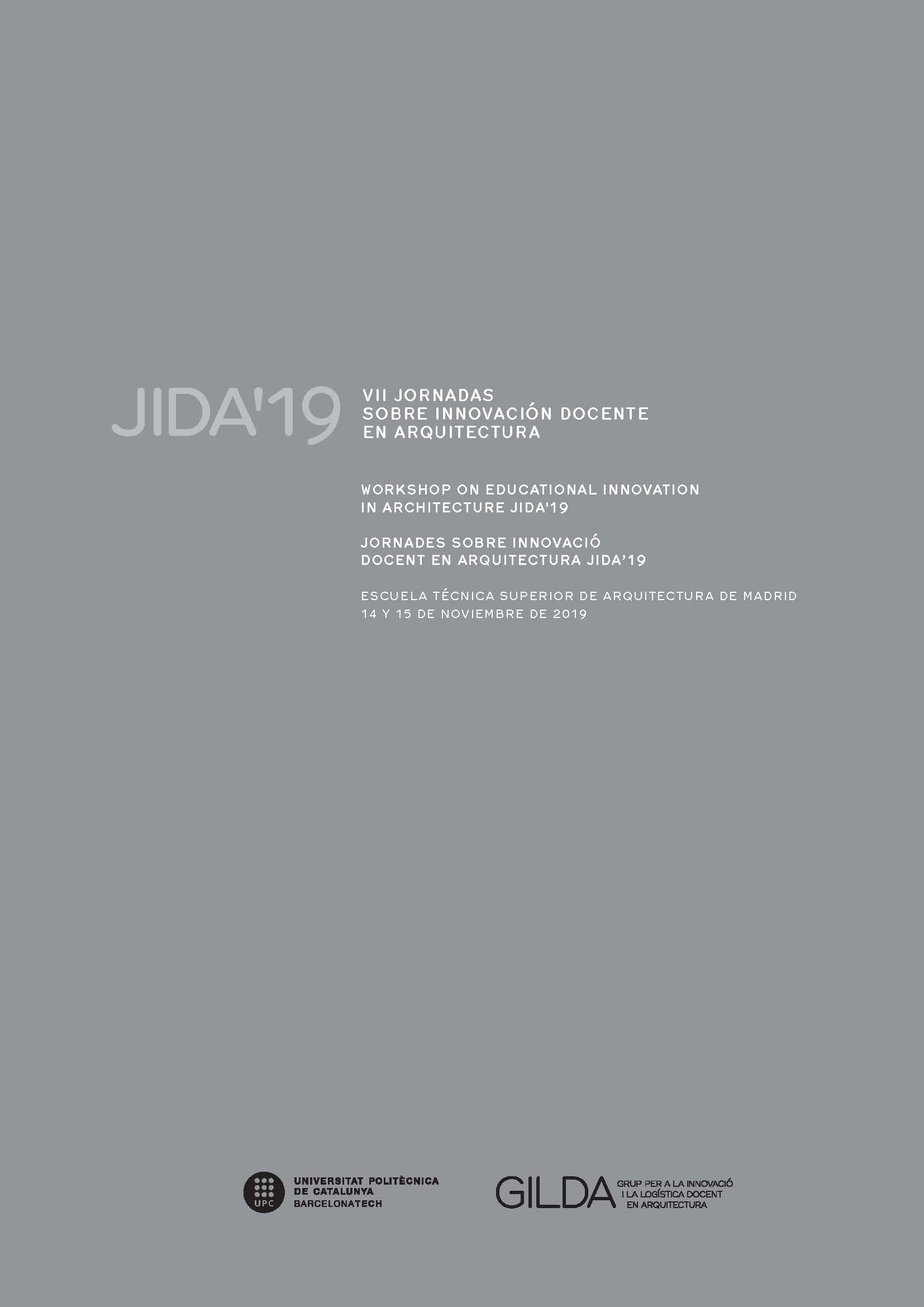Incorporating blended learning to the architectural design-studio
DOI:
https://doi.org/10.5821/jida.2019.8391Abstract
Blended learning (BL) can be very useful to improve teaching in standard Architectural design-studios currently taught in Spanish public universities. Studios are the teaching core of all disciplines related to design in general and architecture in particular. At the School of Architecture of Madrid this system is used by all units in the Department of Architectural Projects. However, the fact that a model Works well does not mean there is no room for improvement left. In fact, both the academic performance results and the opinions shown by students and teachers indicate that some aspects should be improved. On the other hand, the massive emergence of information and communication technologies (ICT) offers new opportunities for improvement. This study analyzes the advantages and difficulties posed by a specific format of blended learning, using Facebook to expand the teaching capacities of the traditional design-studio.
References
ALAMMARY, A. y SHEARD, Judy, A. (2014). “Blended learning in higher education: Three different design approachesâ€. Australasian Journal of Educational Technology. 30.
ALMONACID-CANSECO, R. (2017). “Innovación docente en Arquitectura para la generación millennialâ€, GarcÃa-Escudero, D. y BardÃ-Milà , B. (coord.) En JIDA: Textos de Arquitectura, Docencia e Innovación, IV Jornadas sobre Innovación Docente en Arquitectura JIDA’16 (4. 2016. Valencia ETSA-UPV). Barcelona: Publicaciones Acadèmiques Digitals de la UPC, p. 36-41.
AREA, M. y ADELL, J. (2009). “E-Learning: enseñar y aprender en espacios virtualesâ€. La formación del profesorado en la era de Internet, p. 391-424.
BARDà i MILÀ, B, GARCÃA-ESCUDERO, D. (2017). “Dos modelos pedagógicos: conocer versus saber hacerâ€. GarcÃa-Escudero, D. y BardÃ-Milà , B. (coord.) En JIDA: Textos de Arquitectura, Docencia e Innovación, IV Jornadas sobre Innovación Docente en Arquitectura JIDA’16 (4. 2016. Valencia ETSA-UPV). Barcelona: Publicaciones Acadèmiques Digitals de la UPC, p. 16-35.
BARTOLOMÉ, A. (2004). “Blended learning. conceptos básicosâ€. PÃxel-Bit. Revista de Medios y Educación, 23, p. 7-20.
BARTOLOMÉ, A, GARCÃA-RUIZ, R. y AGUADES, I. (2018). “Blended learning: panorama y perspectivasâ€. RIED. Revista Iberoamericana de Educación a Distancia, 21 (1), p. 33-56.
BHOWMIK, J., PHILLIPS, B. y MEYER, D. (2018). “Blended learning in higher education: a case study in postgraduate applied statistics programsâ€. M.A. Sorto, A. White, & L. Guyot (eds), en Looking back, looking forward. Proceedings of the Tenth International Conference on Teaching Statistics (ICOTS10) (julio, 2018, Kyoto, Japon). Voorburg, Paises Bajos: International Statistical Institute.
BINGHAM, N. (1993). “The education of the architectâ€. En proceedings of the 22nd annual symposium of the Society of Architectural Historians of Great Britain. Londres, Society of Architectural Historians of Great Britain.
CARDAK, C.S. y SELVI, K. (2016). “Increasing teacher candidates' ways of interaction and levels of learning through action research in a blended courseâ€. Computers in Human Behavior, 61, p. 488-506.
DZIUBAN, C., GRAHAM, C., MOSKAL, P., NORBERG, A. y SICILIA, N. (2018). “Blended learning: the new normal and emerging technologiesâ€. International Journal of Educational Technology in Higher Education 15/1.
GALLARDO-ECHENIQUE, B. y MARQUÉS-MOLÃAS, L. (2016). “Student communication and study habits of first-year university students in the digital eraâ€. Canadian Journal of Learning & Technology, 42(1).
GARRISON, D. y KANUKA, H. (2004). “Blended Learning: Uncovering Its Transformative Potential in Higher Educationâ€. The Internet and Higher Education, 7, p. 95-105.
GRAHAM, C., WOODFIELD, W y HARRISON, J. (2013). “A framework for institutional adoption and implementation of blended learning in higher educationâ€. The Internet and Higher Education, 18.
GREEN, L. y BONOLLO, E. (2003). “Studio-based teaching: history and advantages in the teaching of designâ€. World Transactions on Engineering and Technology Education, Vol. 2, No. 2, p. 269-272.
GROPIUS, W. (1962). Scope of Total Architecture. Nueva York: Collier Books.
HETERICK, B. y TWIGG, C. (2003). The Learning MarketSpace. Online, retrieved from http://www.center.rpi.edu/LForum/LM/Feb03.html
HESKETT, J. (1997). Industrial Design. Londres: Thames and Hudson.
LYAPINA, I., SOTNIKOVA, E., LEBEDEVA, O., TATIANA, N. y SKVORTSOVA, N. (2019). “Smart technologies: perspectives of usage in higher educationâ€. International Journal of Educational Management. 33.
MEANS, B., TOYAMA, Y., MURPHY, R. y BAKIA, M. (2013). “The effectiveness of online and blended learning: a meta-analysis of the empirical literatureâ€. Teachers College Record, 115.
OLIVER, M. y TRIGWELL, K. (2005). “Can ‘blended learning’ be redeemed?â€. Journal Indexing and Metrics. Volume: 2 issue: 1, p. 17-26. Issue published: March 1.
SALAMA, A. (2015). “Introduction: sustaining the discourse on architectural design pedagogyâ€. Spatial Design Education. New directions for pedagogy in architecture and beyond. New York: Ashgate Publishing. 358 páginas.
SALINAS, J., DE BENITO, B., PEREZ, A. y GISBERT, M. (2018). “Blended learning, más allá de la clase presencial. Blended learning, beyond the classroomâ€. RIED. Revista Iberoamericana de Educación a Distancia, 21 (1), p. 195-213.
SENTIERI, C. (2017). “OIKONET, una plataforma colaborativa: integración en un taller de proyectosâ€. GarcÃa-Escudero, D. y BardÃ-Milà , B. (coord.) En JIDA: Textos de Arquitectura, Docencia e Innovación, IV Jornadas sobre Innovación Docente en Arquitectura JIDA’16 (4. 2016. Valencia ETSA-UPV) Barcelona: Publicaciones Acadèmiques Digitals de la UPC, p. 152-173.
SPRING, K., GRAHAM, C. y HADLOCK, C. (2016). “The Current Landscape of International Blended Learningâ€. International Journal of Technology Enhanced Learning, Volumen 8, Issue 1.
TUTALENI I. y ALANA, P. (2019). “Student Perceptions on the Role of the Classroom Environment on Computer Supported Collaborative Learning“. TechTrends. March 2019, Volume 63, Issue 2, p. 179-187.
TWIGG, C. (2003). “Improving learning and reducing costs: new models for online learningâ€. Educause Review Volume, 38, Number 5.



















